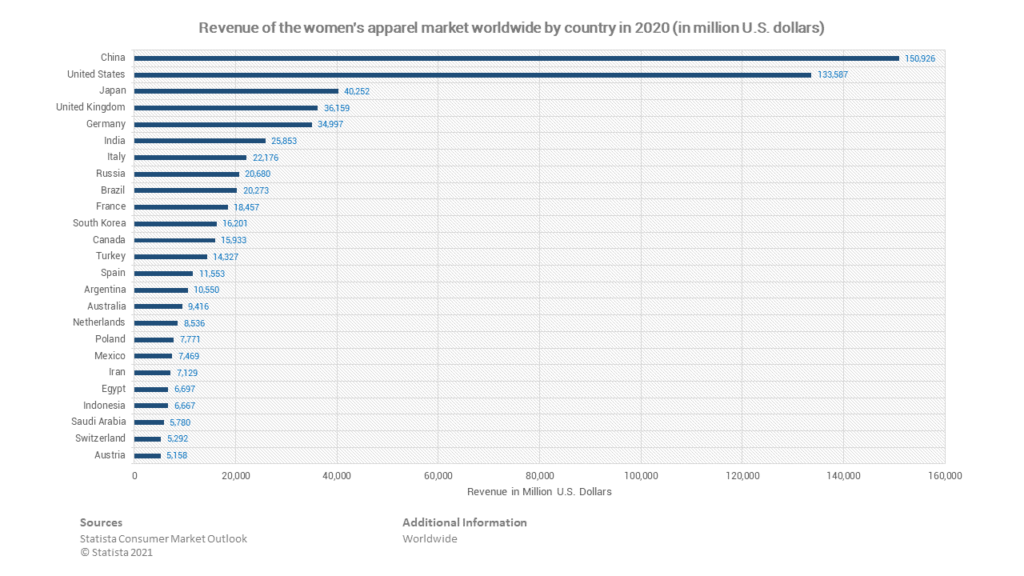According to Statista Market Outlook, the women’s clothing market includes apparel for women and girls. Except for babies’ clothes, children’s clothes are not separately defined. The women’s clothes product ranges incorporate the largest share in revenue within the whole clothing market. The market for women’s apparel is subdivided into the following categories: coats and outdoor jackets, blazers, suits dresses, skirts, trousers and sweatshirts, and blouses. It is bigger than the apparel market for men, since women tend to shop more consumer items in general and fashion items in particular.
In 2020, the worldwide women’s clothing market revenue was valued at more than USD 1.3 billion and is estimated to register a CAGR of 4.7% until 2025.

This growth is affected by the growing women population, the rising number of working women, evolving fashion trends, and the increasing consumers’ spending power. What’s more, apparel manufacturers and brands are continuously presented with new designs and styles, driven by the rapid social media and celebrity influence. Many brands also expand their consumer base, whether it is through e-commerce websites, offering discounts, endorsements, or customization in order to dedicate their endeavors.
The Major Factors
As the ratio of women keeps increasing, as well as the number of working woman population, this gives a positive impact on the women’s clothing market revenue. Women comprise approximately 39% of the workforce worldwide, according to World Bank Data.
According to UN Women, the number has seen an uphill trend in the last two decades. As the feminine society segment finally has better access, many brands and manufacturers are continuously offering and providing more stylish and trendy products, giving a contribution to the growing demands. In addition, many factors like clothing trends innovation, endorsement, fashion media, and magazines, the women’s clothing market revenue rapidly grew in 2022.
Also, these days brands aren’t only about innovating unique and trendy products in general, but they also try to introduce more types of apparel, footwear, and accessories for various occasions. Well, now we know why the women’s clothing market revenue has been increasing. It is also influenced by the growth of social media and influencers across the world.
Top 10 Countries of Worldwide Women’s Clothing Revenue in 2020
China had the biggest per-country worldwide women’s clothing market revenue in 2020 with approximately USD 150 billion. Followed by the United States with a revenue of USD 133 million, then Japan, the United Kingdom, and Germany with revenues of around USD 35 – 40 million in 2020.
Here is the top 10 country list:
- China (USD 150 million)
- United States (USD 133 million)
- Japan (USD 40.2 million)
- United Kingdom (USD 36.1 million)
- Germany (USD 34.9 million)
- India (USD 25.8 million)
- Italy (USD 22.1 million)
- Russia (USD 20.6 million)
- Brazil (USD 20.2 million)
- France (USD 18.4 million)
The Women’s Clothing Revenue Insight for 2021 – 2026
The Women’s Clothing market revenue in the United States is estimated at USD 178.8 Billion in the year 2021. China, the world`s second-largest economy, is forecast to reach a projected market size of USD 151.4 Billion by the year 2026 trailing a CAGR of 5.2% over the analysis period. China is the world’s largest women’s clothing market.
Among the other noteworthy worldwide markets are Japan and Canada, each forecast to grow at 0.7% and 2.1% respectively over the analysis period. Within Europe, Germany is forecast to grow at approximately 1.3% CAGR.
Amidst the COVID-19 crisis, the global market for women’s clothing was estimated at USD 645.5 million in the year 2020 and is projected to reach a revised size of USD 763.9 million by 2026, growing at a CAGR of 2.8% over the analysis period. Coats & Jackets, one of the segments analyzed in the report, is projected to record a 3.1% CAGR and reach USD 111.7 million by the end of the analysis period.
After an in-depth analysis of the business implications of the pandemic and its induced economic crisis, growth in the Blazers, Suits & Ensembles segment is readjusted to a revised 2.4% CAGR for the next 7-year period. Clothing designs, tech pack making and production show a similar trend.
Conclusion
Even though the women’s clothing market revenue in 2019 had a downfall caused by the COVID-19 crisis, it has rapidly grow since 2020. Shirts, Blouses, Dresses & Skirts, one of the segments analyzed in the report, is projected to record a 6.4% CAGR and reach USD 213.3 million by the end of the analysis period.
Globally, the United States, Canada, Japan, China and Europe will drive the 4.6% CAGR estimated. These regional markets accounting for a combined market size of USD 78.6 million in the year 2020 will reach a projected size of USD 107.5 million. Remaining as one of the fastest growing, China will still be on top 5 in the regional markets. Led by countries like Australia, India, and South Korea, the market in Asia-Pacific is forecast to reach USD 131.6 million by the year 2027, while Latin America will expand at a 5.2% CAGR. The outlook for brand and new product development remains positive for the future.




